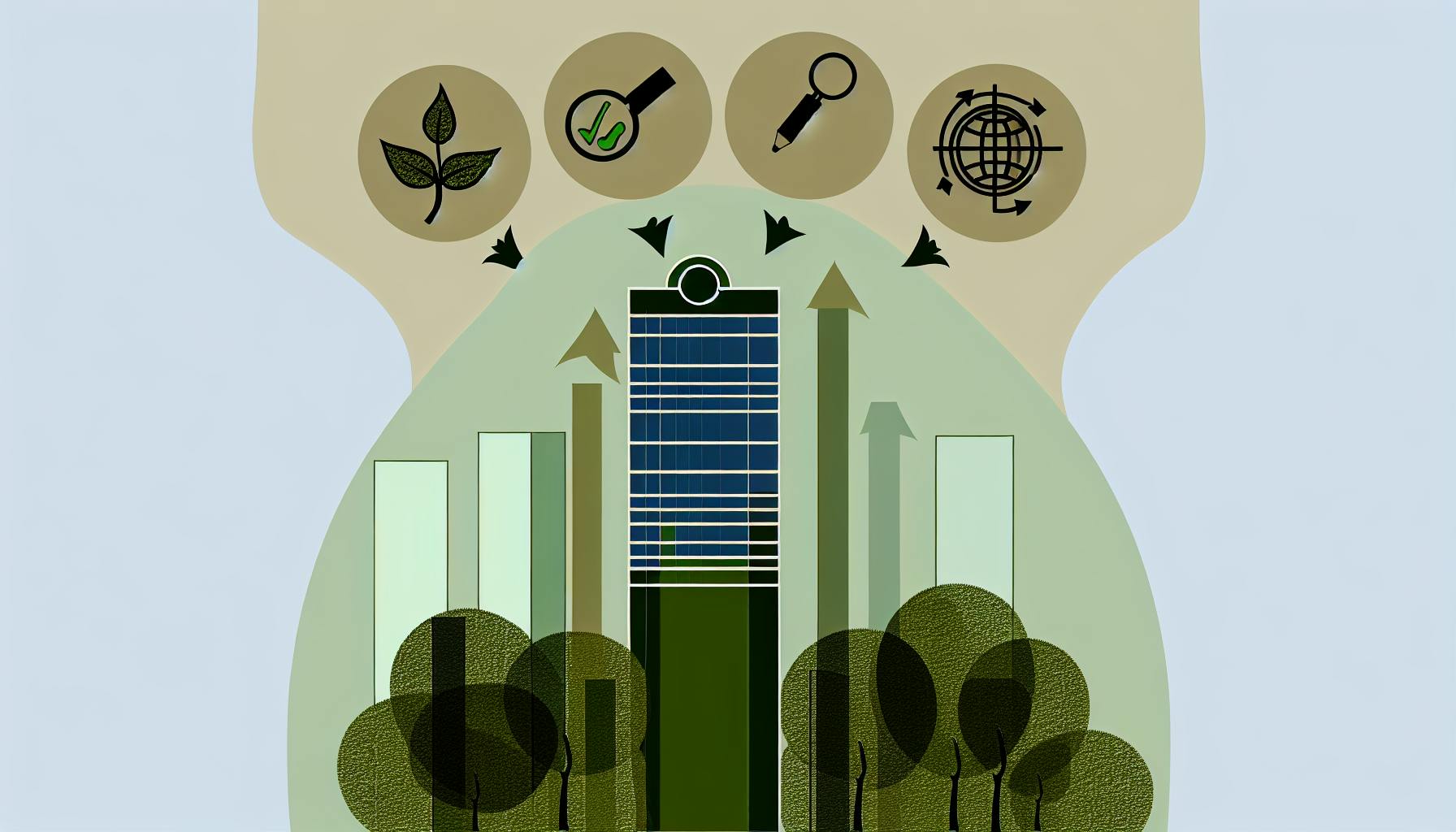We can all agree that reducing our environmental impact is crucial,
and innovative SaaS solutions provide efficient ways for companies to diminish their eco-footprints.
This article explores 20 ways SMEs can leverage SaaS tools to implement sustainability best practices - from streamlining operations to offsetting carbon emissions.
Embracing SaaS to Diminish Environmental Footprints
SaaS solutions provide businesses with efficient tools to measure and reduce their environmental impact. By leveraging cloud-based software, SMEs can streamline carbon accounting and reporting to minimize their eco footprint.
Understanding 'Reduce Carbon Footprint' Meaning
Reducing carbon footprint refers to efforts made to lower the amount of carbon dioxide and other greenhouse gases emitted into the atmosphere. This directly decreases an organization's environmental impact and contributes to climate change mitigation globally. SaaS solutions equip companies to calculate emissions across operations and supply chains. Understanding carbon footprint drives strategic emission reduction targets.
The Eco-conscious Movement in Business
Many modern enterprises recognize the need for urgent climate action and are pivoting operations in an eco-friendly direction. This sustainable movement is motivated by:
- Government regulations and shareholder pressures for transparency on emissions
- Competitive advantages from leading in green business practices
- Cost savings and optimized efficiency through better energy management
- Enhanced brand reputation and customer loyalty
This growing adoption of eco-conscious policies is enabled by SaaS platforms providing easy sustainability measurement and reporting.
Technology as a Catalyst for Change
SaaS solutions allow SMEs to gain actionable carbon insights that catalyze real impact, including:
- Automated data collection and analysis identifying largest emission sources
- Personalized reduction strategies based on emission patterns
- Engaging stakeholders through sustainability communications
- Ongoing tracking of decrease in eco footprint over time
With streamlined access to emission intelligence, companies can diminish footprints and accelerate environmental wins.
How can ecological footprints be reduced?
Reducing your ecological footprint can seem daunting, but taking small, consistent actions adds up over time. Here are some practical ways to get started:
Buy local and organic products when possible
Choosing locally-grown produce cuts down on emissions from long-distance shipping. Organic products also help by eliminating synthetic fertilizers and pesticides that can pollute soil and waterways. Even making these choices for some of your purchases makes an impact.
Reduce energy use
Turn off lights and unplug appliances when not in use. Adjust your thermostat to save heating and cooling energy. Upgrade old appliances and electronics to more energy-efficient models. Investing in renewable energy for your home also dramatically cuts emissions over time.
Cut down on waste
Use reusable bags, bottles, and containers. Compost food scraps. Recycle all accepted items and properly dispose of hazardous waste. Choosing products with less packaging helps too. These small daily choices really do make a measurable difference!
By integrating simple eco-friendly actions into your routine, you can meaningfully reduce your personal ecological footprint. Focus on changes that work for your lifestyle so that sustainability becomes a natural habit.
What are 5 ways you can reduce your footprint?
Reducing your ecological footprint is an important way to lower your environmental impact. Here are 5 impactful yet achievable steps you can take:
Use Renewable Energy
Switch your home and business energy use to renewable sources like solar or wind power. This reduces reliance on fossil fuels that emit greenhouse gases. Products like EcoHedge can help track related emission reductions.
Eat Less Meat
Livestock production requires significant land, water and energy resources. Limiting meat consumption, especially beef and lamb, reduces your food-related footprint. Consider participating in initiatives like Meatless Mondays.
Fly Less
Air travel leaves a large carbon footprint. Reduce flights taken where possible, or offset emissions by supporting verified carbon removal projects. Consider video conferencing as an alternative when feasible.
Drive Less
Walk, bike, use public transport or carpool when you can. If buying a car, choose an electric or hybrid vehicle. Regularly maintaining your car also helps it run more efficiently and pollute less.
Buy Eco-Consciously
Support businesses that prioritize sustainability. Choose products with minimal, recyclable or biodegradable packaging. Buy quality goods built to last like electronics or furniture. Mend, share and repurpose items whenever possible.
What is reducing environmental footprint?
Reducing your environmental footprint refers to taking actions that lower the harmful impact you have on the planet. This includes reducing your carbon footprint - the amount of greenhouse gas emissions caused directly or indirectly by your actions.
Some effective ways businesses can reduce their eco footprint include:
- Conduct an emissions audit to identify your largest sources of emissions. This allows you to prioritize reduction efforts. Popular carbon accounting tools like EcoHedge make auditing simple.
- Improve energy efficiency by updating equipment, optimizing operations, and engaging staff. Smart building analytics tools can automatically reduce wasted energy.
- Source renewable power either by installing on-site solar generation or signing contracts for 100% renewable electricity with utilities. This dramatically lowers emissions.
- Electrify vehicles & equipment by transitioning fleets to electric models and installing EV charging infrastructure. Government incentives can offset upfront costs.
- Engage employees through contests and rewards programs to identify sustainability ideas and foster buy-in at all levels.
By taking a data-driven approach and leveraging the latest technologies, small businesses can make meaningful progress in shrinking their environmental footprint while also reducing operating costs. The key is starting with an accurate picture of your emissions through tools that simplify carbon accounting. This allows you to set informed targets, execute targeted reductions, and clearly demonstrate your commitment to stakeholders.
How can we reduce eco?
Reducing your ecological footprint can seem daunting, but it doesn't have to be. Here are some simple, practical steps you can take to decrease your environmental impact:
Use Resources Wisely
- Save water. Take shorter showers, turn off the tap when brushing your teeth, and install water-efficient appliances. Every drop counts.
- Reduce energy use. Switch to energy-efficient LED lightbulbs, unplug devices when not in use, and adjust your thermostat. Small changes add up.
- Cut food waste. Meal plan, use leftovers creatively, and compost food scraps. Preventing waste saves money and helps the planet.
Make Climate-Conscious Purchases
- Shop secondhand. Buying from thrift and consignment shops extends the lifecycle of clothing and other goods. Vintage is eco-chic!
- Support green brands. Seek out companies committed to sustainability. Your dollar is your vote for change.
- Buy local. Shopping small reduces transport emissions and boosts your community. It's a win-win.
Travel and Commute Sustainably
- Walk, bike or take transit. Leaving your car at home reduces greenhouse gas emissions and promotes better health.
- Fly less. Consider staycations or destinations accessible by train or bus. When you must fly, buy carbon offsets.
- Carpool. Sharing rides cuts fuel consumption and brings people together. Coordinate with friends, family or coworkers.
The path to reducing our eco footprint starts with small, mindful changes. What step will you take today?
sbb-itb-919600f
10 Ways to Reduce Ecological Footprint Using SaaS
Businesses today face increasing pressure to reduce their environmental impact. Implementing software-as-a-service (SaaS) solutions can help companies streamline operations, engage employees, and lower their overall ecological footprint. Here are 10 impactful strategies:
Streamlining Operations with Cloud Computing
Transitioning from on-premise IT infrastructure to cloud-based services significantly cuts energy usage. Cloud platforms consolidate computing power in efficient data centers, reducing the need for power-hungry servers and hardware. Going paperless with cloud collaboration and storage also minimizes waste.
Automated Energy Efficiency Measures
Smart building management systems leverage IoT sensors and software to track energy consumption. They can regulate lighting, HVAC systems, and other equipment to minimize waste. These SaaS tools provide real-time insights to inform sustainability initiatives. Their automation and intelligence optimize efficiency.
Employee Engagement and Virtual Workspaces
Enabling remote work reduces emissions associated with commuting and offices. SaaS facilitates this through digital workspaces and video conferencing. Green travel programs integrated with such software also encourage sustainability. Gamification inspires teams to reduce their environmental impact.
Data-Driven Waste Reduction
Analytics dashboards give companies better visibility into waste streams. They can benchmark progress over time. Identifying optimization opportunities drives resourcefulness. SaaS provides data consolidation for a unified view across facilities. This intelligence powers waste reduction efforts.
Sustainable Resource Planning
From assessing lifecycle impacts to forecasting renewables adoption, SaaS solutions plan for leaner operations. They model complex scenarios to chart the cleanest supply chains, technologies, and growth strategies. Efficiency potentials reveal optimal routes to emission reductions.
SaaS provides the insights and infrastructure for companies to shrink their environmental footprint. Its solutions activate sustainability across organizations - from C-suite strategizing to individual employee actions. With SaaS enabling their decarbonization journey, businesses can better fulfill ecological stewardship duties.
20 Ways to Reduce Your Ecological Footprint with SaaS Innovations
SaaS solutions offer innovative ways for companies to reduce their environmental impact. Here are 20 ways SMEs can leverage SaaS to shrink their ecological footprint:
Enhancing Supply Chain Transparency
Supply chain visibility is key to promoting sustainability. SaaS platforms provide real-time tracking of supplier environmental performance, enabling corrective actions. Cloud-based solutions also facilitate supply chain mapping to identify eco-friendly partners.
Adopting Green Hosting Solutions
Shifting to renewable energy-powered web hosting significantly reduces emissions. SaaS products from green data centers minimize environmental harm.
Utilizing Teleconferencing to Reduce Travel
Replacing business trips with teleconferencing powered by SaaS eliminates travel emissions. Virtual meeting solutions make remote collaboration simple and effective.
Eco-friendly Customer Service Tools
Cloud-based CRM and helpdesk solutions reduce paper usage for improved sustainability. Chatbots and knowledge bases also decrease inquiries for more efficient service.
SaaS for Corporate Sustainability Training
Web-based training programs raise employee awareness of environmental best practices. SaaS learning platforms make rollout and tracking easy.
With innovative SaaS solutions, SMEs can implement impactful sustainability initiatives to reduce their eco footprint. The cloud streamlines emissions tracking, supply chain transparency, renewable software hosting, paperless operations, remote work, and more. By leveraging these digital tools, companies take meaningful steps towards net zero.
100 Ways to Reduce Carbon Footprint: The SaaS Edition
Explore a diverse and detailed compilation of 100 methods SaaS can enable businesses to cut down on carbon emissions, providing an exhaustive resource for SMEs.
Comprehensive Energy Management Systems
SaaS solutions offer advanced energy management systems that can significantly reduce energy usage across all business operations. By consolidating energy data into a single dashboard, companies gain visibility into wasted energy and opportunities for efficiency. Features like real-time monitoring, automated alerts, and predictive analytics empower businesses to optimize energy consumption. Studies show SaaS-enabled energy management can reduce carbon emissions by over 20% annually.
Optimized Inventory and Order Processing
Just-in-time inventory management through SaaS platforms leads to reduced emissions from overproduction and storage. By synchronizing order data across the supply chain, companies prevent overstock situations leading to excessive electricity usage in warehouses. Streamlining ordering also minimizes delivery transportation resulting in lower fuel emissions. SaaS analytics provide granular insight to align production with real demand. Implementing such optimized inventory processes enabled a manufacturing SME to decrease its carbon footprint by 30%.
Green Procurement Platforms
SaaS marketplaces help companies source environmentally friendly materials, reducing their overall footprint. These platforms aggregate, evaluate and recommend suppliers of sustainable products. Features like supplier questionnaires, product declarations and impact calculators simplify comparing offerings. By accessing such networks, an SME switched 70% of its office supplies to eco-friendly vendors, significantly decreasing emissions from materials and transportation.
SaaS in Carbon Offsetting Initiatives
Specialized SaaS solutions assist businesses seeking to invest in carbon offset projects as part of their reduction strategy. They efficiently assess company emissions, model offset investment scenarios, provide accredited offset options and transparently track progress. Offset initiatives funded through such platforms include reforestation drives, renewable energy farms and clean cooking stove projects. An SME leveraging this SaaS solution attained carbon neutral status by offsetting all non-reducible emissions.
Renewable Energy Tracking and Adoption
SaaS tools enable tracking renewable energy usage and identifying opportunities to switch. Monitoring features quantify on-site solar/wind generation and purchased clean power. Comparison functionality benchmarks performance against industry standards, model ideal renewable energy roadmaps and recommend certified green utilities and hardware vendors. By implementing recommendations from its SaaS advisor, a small retailer increased renewable power utilization by 85% within a year.
Global Perspectives: Ways to Reduce Carbon Emissions with SaaS
SaaS platforms provide scalable solutions to help companies across industries and regions measure, report on, and reduce their carbon emissions. By fostering collaboration, enabling renewable energy markets, standardizing best practices, and aligning sustainability with CSR goals, SaaS is contributing to the global effort against climate change.
International Collaboration through SaaS
SaaS allows companies to collaborate internationally on carbon reduction projects in several ways:
- Cloud-based platforms facilitate real-time data sharing and communication between sustainability teams across regions and time zones. This streamlines coordination on global initiatives.
- Automated reporting templates provided by SaaS ensure standardization of emissions data across all locations. This enables consolidated tracking and benchmarking.
- Partner ecosystems created by some SaaS vendors connect companies to other firms worldwide that can help them procure renewable energy, invest in offsets, or implement reduction strategies.
SaaS in Promoting Renewable Energy Markets
By making carbon accounting easier, SaaS solutions encourage companies to switch to renewable energy:
- Energy source tracking features help companies measure emissions specifically from non-renewables. This motivates shifts to solar, wind, etc.
- Some platforms integrate directly with renewable energy certificate (REC) markets to facilitate procurement.
- Automated reporting highlights the positive environmental impact of renewable energy spend to stakeholders.
Benchmarking and Sharing Best Practices
SaaS enables collaboration between companies to establish emissions benchmarks and share reduction tactics:
- Cloud-based tools allow centralized databases of sector-specific benchmarks to be created through anonymized data pooling.
- Standardized reports allow more consistent comparison of emissions performance across peers.
- Online communities facilitate discussions between sustainability teams on challenges faced and best practices.
SaaS and Corporate Social Responsibility
By automating measurement and reporting of emissions data, SaaS helps embed sustainability into CSR programs:
- Streamlined carbon accounting better allocates resources towards environment programs versus manual tracking.
- Centralized data aids more regular monitoring and reporting for CSR disclosures.
- Tools can quantify impacts of reduction initiatives on emissions as part of CSR results tracking.
In summary, SaaS can enhance global coordination, renewable energy use, collaboration, and accountability - all crucial for driving climate action across borders.
Conclusion: Synthesizing SaaS's Role in Eco-Friendly Business Practices
SaaS solutions can play a significant role in helping small and medium-sized enterprises (SMEs) reduce their environmental impact and become more sustainable. By providing automated and efficient carbon accounting, reporting, and stakeholder engagement tools, SaaS platforms like EcoHedge empower businesses to measure, understand, and reduce their carbon footprints.
As discussed throughout this article, implementing SaaS solutions enables SMEs to:
- Accurately calculate emissions across their operations and supply chains
- Identify "hot spots" to target for emissions reductions
- Track progress towards net-zero goals over time
- Seamlessly collect data and generate comprehensive reports
- Communicate sustainability achievements with stakeholders
- Make data-driven decisions to implement environmentally-conscious business practices
With global momentum growing around corporate environmental responsibility, SaaS solutions are well-positioned to facilitate emissions reductions on a broad scale. Easy-to-use, automated SaaS platforms can removes traditional barriers of complex carbon accounting processes, lack of internal expertise, and manually tracking metrics over time.
Overall, SaaS solutions empower businesses of all sizes to minimize ecological impact, helping drive collective progress towards crucial climate change mitigation targets. Their efficiency, scalability and real-time insights accelerate the sustainability journey for SMEs across diverse sectors.
Recapitulating SaaS's Eco Benefits
In summary, adopting SaaS-based carbon accounting and reporting solutions provides multifaceted benefits:
- Cost Savings: Eliminates expenses for on-premise servers, manual data collection/reporting, sustainability consultants.
- Efficiency Gains: Automates previously tedious, repetitive carbon accounting tasks.
- Expertise Access: Provides latest methodology/regulatory knowledge without internal skills.
- Stakeholder Engagement: Enables easy communication about sustainability initiatives.
- Emissions Reduction: Identifies “low-hanging fruit” for quick carbon footprint decreases.
As the above points demonstrate, SaaS solutions empower organizations to enhance environmental stewardship in a fast, affordable manner.
Future Outlook: Sustainable Business with SaaS
Looking ahead, the flexibility and innovativeness of SaaS solutions positions them to play an integral role as more enterprises pursue net-zero emissions. As capabilities expand, SaaS platforms could provide value-chain-wide accounting, machine learning for emissions forecasting, goal-setting recommendations, offset purchasing, and more.
Additionally, by interoperating with other systems, SaaS solutions may increasingly integrate sustainability considerations into everyday business decisions on procurement, operations, product development and beyond. The promise for technology to embed environmental consciousness into processes across organizations is immense.
Encouraging Action and Implementation
For SMEs seeking to initiate or accelerate their sustainability journeys, adopting user-friendly SaaS solutions is a logical first step. By providing fast, reliable insights on emission baselines and reduction opportunities, these tools lay the data foundation for achieving net-zero ambitions.
Now is the time for businesses to gain transparency into their environmental footprints, engage stakeholders on progress, contribute to collective climate goals, and thrive in an increasingly eco-conscious economic landscape. SaaS solutions make this transition straightforward, allowing companies to lead by example while enhancing efficiency and value.



